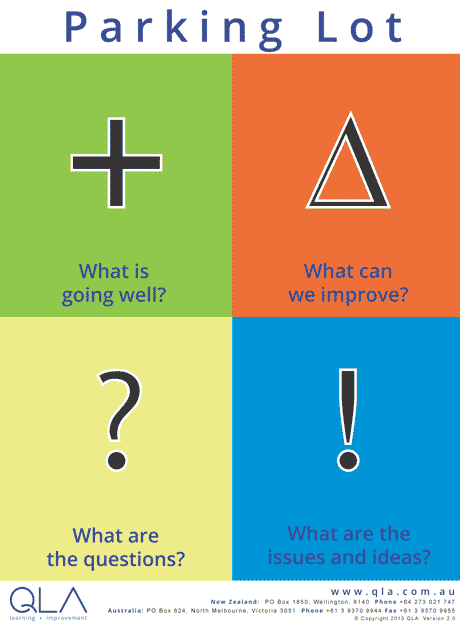Unlike in the well-known Joni Mitchell (or for those of you who are younger, the Counting Crows) Big Yellow Taxi song, putting up a Parking Lot can be a very positive and productive experience. Especially when the Parking Lot is a Quality Learning tool!
Like the key message in the song, the Parking Lot can prevent us from taking things for granted, and missing opportunities – but in a very different way.
 Our colleague and friend David Langford was responsible for the ‘construction’ of this Parking Lot.
Our colleague and friend David Langford was responsible for the ‘construction’ of this Parking Lot.
The Quality Learning Parking Lot enhances communication and supports our continual improvement efforts.
The purpose of a Parking Lot is to
gather feedback from stakeholders.
It is where we ‘park’ ideas for improvement.
The Parking Lot can be used to gather group, team or individual feedback, ideas and reflections. Stakeholder feedback is usually collected anonymously. This allows people to provide honest feedback in a safe and trusting environment.
How to…
Easier to construct than a traditional parking lot, (no need for a bulldozer and tons of concrete!) – all we need is paper and a pen. The Parking Lot can be as creative and colourful as your imagination allows (and students make great Parking Lots!). Here’s how:
- Use poster size paper (or smaller for individual use).
- Draw up the Parking Lot to capture thinking in four main areas:
- +: What is going well?
- Δ: What can we improve?
- ?: What are the questions?
- I: What are the issues or ideas?
- Gather the feedback using either sticky notes, or allow people to write directly onto a template. Ask users to place their feedback directly onto the quadrant it relates to.
- Collate the feedback (where sticky notes have been used, an Affinity Diagram can help with this).
- With the stakeholder/s: discuss, explore, agree priorities, and action.
A word of warning: don’t ask for feedback if you are not prepared to discuss and act upon it!
When and where…
At QLA, we use a Parking Lot to collect feedback during meetings, professional development and support sessions. That way we can improve the process during the session, rather than wait to gather feedback at the end, when it is too late to attend to the needs of the current participants.
Here are some other ideas for application:
 Educator
Educator
- As a basis for classroom meetings. Ask students to place their ideas as they emerge during classroom and learning activities during the week. Students take it in turns to chair a meeting. Each idea is read out and the appropriate action determined and agreed to by students in consultation with the teacher. Actions and agreements can be recorded using an Decision and Action Record.
- To obtain student feedback on programs, units of work, lessons, excursions, activities, homework, the effectiveness of teaching strategies.
- To structure group or individual reflection on learning.
- As part of a class project or Plan-Do-Study-Act (PDSA) improvement process to capture ongoing feedback and ideas.
 School Leader
School Leader
- Posted in the school’s reception area to collect ongoing feedback from parents and families on various aspects of school life and activities.
- During meetings to evaluate effectiveness and ‘park’ ideas and issues that emerge that the current agenda may not allow time for.
- To gather input from staff to evaluate a program, professional development, school processes (as part of a post–process review – e.g. reporting to parents, school camp), to improve the process for next time.
- As part of a project or Plan-Do-Study-Act (PDSA) improvement process to capture ongoing feedback and ideas as the project progresses.
 School System Leader
School System Leader
- During meetings to evaluate effectiveness and ‘park’ ideas and issues that emerge that the current agenda may not allow time for.
- To gather input to evaluate, progress and/or improve a project, program, professional development, processes.
- As part of a Plan-Do-Study-Act (PDSA) improvement process to capture ongoing feedback and ideas as the process progresses.
 Family and Community Member
Family and Community Member
- To structure group or individual reflection on learning.
- During meetings to evaluate effectiveness and ‘park’ ideas and issues that emerge that the agenda does not allow time for, so they are not lost.
 Business or Government Leader
Business or Government Leader
- During meetings to evaluate effectiveness and ‘park’ ideas and issues that emerge that the agenda does not allow time for, so they are not lost.
- To gather input to evaluate, progress and/or improve a project, program, professional development, processes.
- As part of a Plan-Do-Study-Act (PDSA) improvement process to capture ongoing feedback and ideas as the process progresses.
Find out more…
- Purchase and download a Parking Lot template.
- View a video clip on the use of the Parking Lot in the classroom.
- Learn more about Quality Learning tools.
- Purchase the Tool Time for Education (Quality Learning Tools recipe) book.
Discussion
We’d love to here your experiences with using the Parking Lot!
Please comment here:

Using technology can sometimes be a case of using technology for technology’s sake.
But in this case, using technology to actually achieve an educational outcome that matters is such a practical approach – brilliant concept!
Thanks for sharing.